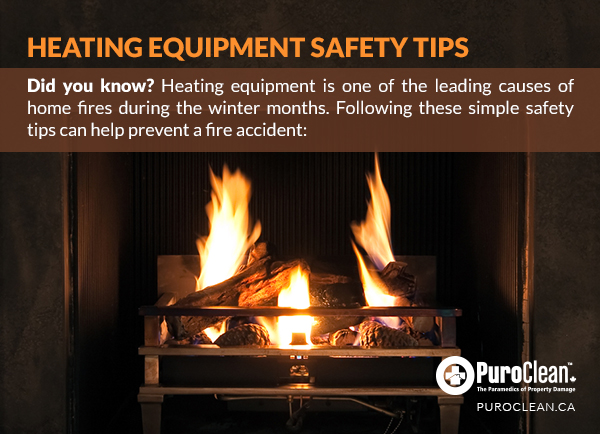The PuroClean Blog
Heating Equipment Safety Tips
 As winter is in full swing, those who enjoy the occasional fire in wood-burning fireplaces or heat their rooms with a woodstove must keep in mind that heating equipment is also one of the leading causes of home fires during the winter months. Following these simple safety tips can help prevent a fire accident:
As winter is in full swing, those who enjoy the occasional fire in wood-burning fireplaces or heat their rooms with a woodstove must keep in mind that heating equipment is also one of the leading causes of home fires during the winter months. Following these simple safety tips can help prevent a fire accident:
- Only qualified professionals should install stoves, chimney connectors, and chimneys.
- Stoves should have the label of an independent testing laboratory.
- The chimney cap should be inspected. If it is damaged, it must be repaired or replaced. (During the summer months, chimneys should be covered with a cap fitted with wire-mesh sides, to keep out debris, rain, squirrels, birds and other critters.)
- Chimneys, stoves and vents should be inspected and cleaned by a certified chimney sweep every fall just before heating season. (A furnace should be serviced at least once a year.)
- The inside of stoves should be cleaned periodically using a wire brush.
- Chimneys should be checked for creosote build-up. Failing to clean the built up creosote is the leading cause for chimney fires. This service needs to be done at least once a year.
- It is very dangerous to use flammable liquids when starting a fire. Kindling should be used instead.
- Wood stoves should burn only dry, seasoned wood. Pellet stoves should burn only dry, seasoned wood pellets.
- A mesh metal screen or glass fireplace doors should be used to prevent embers from shooting out of the fireplace. When using a woodstove, the door must be closed and secured.
- Ashes must cool for several hours before disposing of them. They should be placed in a covered metal container, at least 10 feet away from buildings.
- Children and pets should be supervised whenever a wood or pellet stove is being used. They must be reminded to stay at least 3 feet away from the stove.
- Space heaters must never be placed near drapes, shades or bedding, and never left unattended, especially when children and pets are around.
- Owners of old heaters should consider replacing it with a new model that has more current safety features, such as tip-over protection (these heaters shut off automatically if they happens to fall over).
- Smoke alarms and carbon monoxide alarms (CO) should be installed an maintained outside each sleeping area and on every level of a home. For the best protection, CO alarms should be interconnected. When one sounds, they all sound.
Check back with us for more safety tips and don’t forget to follow us on Twitter, LinkedIn, Facebook and Google+ to get our notifications!
January 28, 2015



